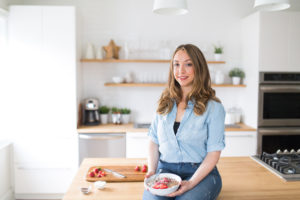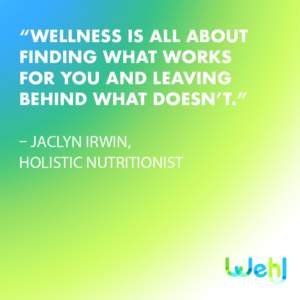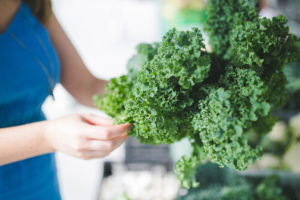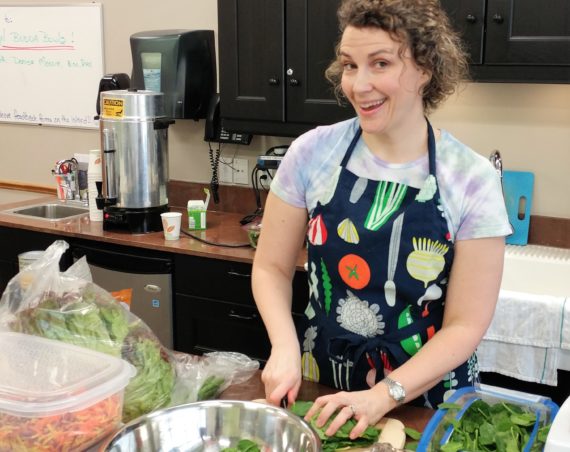It’s that time of the year when it turns dark and cold and many of us feel the winter blues. We wanted to know what we can do to stop hibernating and get out and move our bodies so we connected with Toronto-based Holistic Nutritionist, Jaclyn Irwin. In her nutrition practice, Jaclyn aims to help women end years of yo-yo dieting and develop a healthier relationship with food.
We chatted with Jaclyn about what Seasonal Affective Disorder (SAD) is, what her go-to warming breakfast is and what foods we should avoid in the winter.
 WEHL: What is your philosophy on wellness?
WEHL: What is your philosophy on wellness?
JI: My philosophy is wellness without obsession. This means that while I love all things health and wellness, I don’t do well with restriction or labels. I encourage clients that I work with to explore their own individual preferences when it comes to health, food and nutrition and I don’t provide strict rules or diets to follow. Wellness is all about finding what works for you and leaving behind what doesn’t.

WEHL: Why did you decide to become a holistic nutritionist?
JI: I decided to become a Holistic Nutritionist when I went through my own personal health journey about six years ago. I was tired of not feeling great, suffering from migraines and had started to experiment with alternative health and wellness practices along with changing my own diet. This came about after losing my mom to pancreatic cancer two years prior. I became aware of how food made me feel and wanted to learn more about nutrition so I enrolled in school in 2013.
WEHL: What is Seasonal Affective Disorder (SAD) and why does it affect so many Canadians?
JI: SAD is a type of seasonal depression that occurs during the same season every year. Researchers believe that SAD is caused by changes in the level of exposure to sunlight. It affects so many Canadians because our winters can be long and harsh, and we don’t get to go outside as much and get that natural form of vitamin D from the sun.
WEHL: What are the symptoms of SAD?
JI: One of the most common symptoms of SAD is experiencing a sad despairing mood that lasts for more than two weeks and is present for most of the day. Other symptoms can include: changes in appetite and weight, sleep problems, loss of interest in work or hobbies, irritability, fatigue, agitation and withdrawal from friends and family.

WEHL: What do you do to help keep SAD at bay?
JI: Personally I make an effort to stay active and focus on eating lots of nourishing whole foods, including cooked greens and roasted veggies. I also supplement with vitamin D (always get your levels checked before supplementing), probiotics, fish oil, vitamin C and adaptogens to help with my mood and cognitive function.
WEHL: What are your thoughts on Light Therapy boxes?
JI: I personally haven’t tried one but I have heard good things about them.

WEHL: Cold smoothies are hard to drink in the winter; what’s your go-to morning warming breakfast?
JI: My go-to warming breakfasts include things like: eggs and avocado, stuffed sweet potato, steel cut oats (I love making a big batch in my Instant Pot), baked oatmeal or savoury oats (usually with an egg). Sometimes, I will still make a smoothie, but usually not in very cold months and I do add warming spices to them to help with digestion and to keep me feeling warm.
WEHL: What foods or spices can we add to our daily diets to help warm us up?
JI: I love using warming spices like cinnamon, ginger, turmeric, cayenne, cardamom, cloves, cumin and nutmeg. As for warming foods, I like to make lots of soups, stews, chili and anything else that can be made in a slow cooker or Instant Pot. Other warming foods I love include: sweet potatoes, bone broth, ghee, sipping on tea, beets and kale. I do advise cooking most if not all of the veggies rather than eating them raw.
WEHL: Are there any foods that we should avoid during the winter?
JI: I don’t like to put rules on what people should eat as it’s such an individual thing. With that being said, it is best to avoid eating lots of cold salads in the winter as they usually won’t leave you feeling very warm and cozy as they are cooler foods. You could easily change this by steaming or sautéing your veggies, spinach or kale rather than eating them raw.
WEHL: Do you have a favourite winter recipe that you’d like to share?

JI: You can check out all of my recipes over here on my blog. As for favourites, I love this butternut squash pasta and my pumpkin steel cut oats.
WEHL: What tips do you have to help us stop hibernating and get out and move our bodies?
JI: I would say once you find what you love doing, it truly makes it so much easier to get out there and do it. But also, don’t be afraid to change it up in the winter and try something that is a bit more seasonal. For example, I love doing hot yoga in the winter as it completely warms me up. Find activities that are more winter appropriate and still fun like skating, skiing and dress for the cold. If you need to find someone to do it with then do that; this also makes it harder to cancel plans once you’ve made the commitment with someone else.
WEHL: On these cold, dark evenings, what do you do to practice self-care?
JI: A warm bath always helps!
WEHL: How can mindfulness or meditation help to change our mindset about winter?
JI: I think they both aim to help us be more present with our surroundings and ourselves. When we are able to be more present, we are also able to be more grateful of the things we have in our lives. That gratitude can really change our perspective and our mindset about winter.
Connect with Jaclyn:
- Web: Holisticfoodie.com
- Email: [email protected]
We invite you to join our all-in-one healthy lifestyle app at Wehl.com!




1 Comment
Sherika
This was very informative. As a new resident in Canada, I am experiencing this currently and I couldn’t quite put my finger on what it is. It is great to know that it is something that is common, has a name and there are ways to deal with it. Thanks for this article